Traduzione generata automaticamente
Mostra originale
Mostra traduzione
Marc Chagall, Original Lithograh depicting an instant of the Bible. Technique: Original lithograph in colours (Mourlot no. 234) On the reverse: another black and white original lithograph (Mourlot no. 257) Year: 1960 Sizes: 35,5 x 26 cm / 14'' x 10.2'' (sheet) Published by: Éditions de la Revue Verve, Tériade, Paris Printed by: Atelier Mourlot, Paris Documentation / References: Mourlot, F., Chagall Lithograph [II] 1957-1962, A. Sauret, Monte Carlo 1963, nos. 234 and 257 In 1956, the French art critic and publisher Tériade brought out a special issue of the legendary art magazine Verve, which was exclusively devoted to one of Marc Chagalls major themes: The Bible. For this outstanding issue, Chagall composed 18 full-page colour lithographs and 12 in black and white. For his ''Bible I'' Marc Chagall focused on characters from the Old Testament such as the Founding Fathers, the Kings, the Prophets and Angels. Four years later, in 1960, the follow-up issue ''Illustrations for The Bible'' was published, with another 24 gorgeous color lithographs. Since then, vast numbers of reproductions were put in circulation which are anything but original(!) lithographs. Marc Chagall (born in 1887) Marc Chagall was born in Belarus in 1887 and developed an early interest in art. After studying painting, in 1907 he left Russia for Paris, where he lived in an artist colony on the city’s outskirts. Fusing his own personal, dreamlike imagery with hints of the fauvism and cubism popular in France at the time, Chagall created his most lasting work—including I and the Village (1911)—some of which would be featured in the Salon des Indépendants exhibitions. After returning to Vitebsk for a visit in 1914, the outbreak of WWI trapped Chagall in Russia. He returned to France in 1923 but was forced to flee the country and Nazi persecution during WWII. Finding asylum in the U.S., Chagall became involved in set and costume design before returning to France in 1948. In his later years, he experimented with new art forms and was commissioned to produce numerous large-scale works. Chagall died in St.-Paul-de-Vence in 1985. The Village Marc Chagall was born in a small Hassidic community on the outskirts of Vitebsk, Belarus, on July 7, 1887. His father was a fishmonger, and his mother ran a small sundries shop in the village. As a child, Chagall attended the Jewish elementary school, where he studied Hebrew and the Bible, before later attending the Russian public school. He began to learn the fundamentals of drawing during this time, but perhaps more importantly, he absorbed the world around him, storing away the imagery and themes that would feature largely in most of his later work. At age 19 Chagall enrolled at a private, all-Jewish art school and began his formal education in painting, studying briefly with portrait artist Yehuda Pen. However, he left the school after several months, moving to St. Petersburg in 1907 to study at the Imperial Society for the Protection of Fine Arts. The following year, he enrolled at the Svanseva School, studying with set designer Léon Bakst, whose work had been featured in Sergei Diaghilev's Ballets Russes. This early experience would prove important to Chagall’s later career as well. Despite this formal instruction, and the widespread popularity of realism in Russia at the time, Chagall was already establishing his own personal style, which featured a more dreamlike unreality and the people, places and imagery that were close to his heart. Some examples from this period are his Window Vitebsk (1908) and My Fianceé with Black Gloves (1909), which pictured Bella Rosenfeld, to whom he had recently become engaged. The Beehive Despite his romance with Bella, in 1911 an allowance from Russian parliament member and art patron Maxim Binaver enabled Chagall to move to Paris, France. After settling briefly in the Montparnasse neighborhood, Chagall moved further afield to an artist colony known as La Ruche (“The Beehive”), where he began to work side by side with abstract painters such as Amedeo Modigliani and Fernand Léger as well as the avant-garde poet Guillaume Apollinaire. At their urging, and under the influence of the wildly popular fauvism and cubism, Chagall lightened his palette and pushed his style ever further from reality. I and the Village (1911) and Homage to Apollinaire (1912) are among his early Parisian works, widely considered to be his most successful and representative period. Though his work stood stylistically apart from his cubist contemporaries, from 1912 to 1914 Chagall exhibited several paintings at the annual Salon des Indépendants exhibition, where works by the likes of Juan Gris, Marcel Duchamp and Robert Delaunay were causing a stir in the Paris art world. Chagall’s popularity began to spread beyond La Ruche, and in May 1914 he traveled to Berlin to help organize his first solo exhibition, at Der Sturm Gallery. Chagall remained in the city until the highly acclaimed show opened that June. He then returned to Vitebsk, unaware of the fateful events to come. War, Peace and Revolution In August 1914 the outbreak of World War I precluded Chagall’s plans to return to Paris. The conflict did little to stem the flow of his creative output, however, instead merely giving him direct access to the childhood scenes so essential to his work, as seen in paintings such as Jew in Green (1914) and Over Vitebsk (1914). His paintings from this period also occasionally featured images of the war’s impact on the region, as with Wounded Soldier (1914) and Marching (1915). But despite the hardships of life during wartime, this would also prove to be a joyful period for Chagall. In July 1915 he married Bella, and she gave birth to a daughter, Ida, the following year. Their appearance in works such as Birthday (1915), Bella and Ida by the Window (1917) and several of his “Lovers” paintings give a glimpse of the island of domestic bliss that was Chagall’s amidst the chaos. To avoid military service and stay with his new family, Chagall took a position as a clerk in the Ministry of War Economy in St. Petersburg. While there he began work on his autobiography and also immersed himself in the local art scene, befriending novelist Boris Pasternak, among others. He also exhibited his work in the city and soon gained considerable recognition. That notoriety would prove important in the aftermath of the 1917 Russian Revolution when he was appointed as the Commissar of Fine Arts in Vitebsk. In his new post, Chagall undertook various projects in the region, including the 1919 founding of the Academy of the Arts. Despite these endeavors, differences among his colleagues eventually disillusioned Chagall. In 1920 he relinquished his position and moved his family to Moscow, the post-revolution capital of Russia. In Moscow, Chagall was soon commissioned to create sets and costumes for various productions at the Moscow State Yiddish Theater, where he would paint a series of murals titled Introduction to the Jewish Theater as well. In 1921, Chagall also found work as a teacher at a school for war orphans. By 1922, however, Chagall found that his art had fallen out of favor, and seeking new horizons he left Russia for good. Flight After a brief stay in Berlin, where he unsuccessfully sought to recover the work exhibited at Der Sturm before the war, Chagall moved his family to Paris in September 1923. Shortly after their arrival, he was commissioned by art dealer and publisher Ambroise Vollard to produce a series of etchings for a new edition of Nikolai Gogol's 1842 novel Dead Souls. Two years later Chagall began work on an illustrated edition of Jean de la Fontaine’s Fables, and in 1930 he created etchings for an illustrated edition of the Old Testament, for which he traveled to Palestine to conduct research. Chagall’s work during this period brought him new success as an artist and enabled him to travel throughout Europe in the 1930s. He also published his autobiography, My Life (1931), and in 1933 received a retrospective at the Kunsthalle in Basel, Switzerland. But at the same time that Chagall’s popularity was spreading, so, too, was the threat of Fascism and Nazism. Singled out during the cultural ''cleansing'' undertaken by the Nazis in Germany, Chagall’s work was ordered removed from museums throughout the country. Several pieces were subsequently burned, and others were featured in a 1937 exhibition of “degenerate art” held in Munich. Chagall’s angst regarding these troubling events and the persecution of Jews in general can be seen in his 1938 painting White Crucifixion. With the eruption of World War II, Chagall and his family moved to the Loire region before moving farther south to Marseilles following the invasion of France. They found a more certain refuge when, in 1941, Chagall’s name was added by the director of the Museum of Modern Art (MOMA) in New York City to a list of artists and intellectuals deemed most at risk from the Nazis’ anti-Jewish campaign. Chagall and his family would be among the more than 2,000 who received visas and escaped this way. Haunted Harbors Arriving in New York City in June 1941, Chagall discovered that he was already a well-known artist there and, despite a language barrier, soon became a part of the exiled European artist community. The following year he was commissioned by choreographer Léonide Massine to design sets and costumes for the ballet Aleko, based on Alexander Pushkin’s “The Gypsies” and set to the music of Pyotr Ilyich Tchaikovsky. But even as he settled into the safety of his temporary home, Chagall’s thoughts were frequently consumed by the fate befalling the Jews of Europe and the destruction of Russia, as paintings such as The Yellow Crucifixion (1943) and The Juggler (1943) indicate. A more personal blow struck Chagall in September 1944, when his beloved Bella died of a viral infection, leaving the artist incapacitated with grief. His sadness at the loss of his wife would haunt Chagall for years to come, as represented most poignantly in his 1945 paintings Around Her and The Wedding Candles. Working through his pain, in 1945 Chagall began the set design and costumes for a production of Igor Stravinsky’s ballet The Firebird, which premiered in 1949, ran until 1965 and has been staged numerous times since. He also became involved with a young English artist named Virginia McNeil, and in 1946 she gave birth to their son, David. Around this time Chagall was also the subject of retrospective exhibitions at MOMA and the Art Institute of Chicago. Return After seven years in exile, in 1948 Chagall returned to France with Virginia and David as well as Virginia's daughter, Jean, from a previous marriage. Their arrival coincided with the publication of Chagall's illustrated edition of Dead Souls, which had been interrupted by the onset of the war. The edition of Fables featuring his work was published in 1952, and after Chagall completed the etchings he had begun in 1930, his illustrated bible was published in 1956. In 1950, Chagall and his family moved south to Saint-Paul-de-Vence, on the French Riviera. Virginia left him the next year, but in 1952 Chagall met Valentina “Vava” Brodsky and married her shortly thereafter. Valentina, who became Chagall's no-nonsense manager, is featured in several of his later portraits. Settling into life as an established painter, Chagall began to branch out, working in sculpture and ceramics as well as mastering the art of stained glass windows. Much of his important later work exists in the form of large-scale commissions around the world. Among the highlights from this period are his stained glass windows for the synagogue at the Hadassah Hebrew University Medical Center in Jerusalem (completed 1961), the Saint-Étienne Cathedral in Metz (completed 1968), the U.N. building in New York City (completed 1964) and the All Saint’s Church in Mainz, Germany (completed 1978); the ceiling of the Paris Opéra (completed 1964); and murals for the New York Metropolitan Opera (completed 1964), for whom he also designed the sets and costumes for a 1967 production of Wolfgang Amadeus Mozart’s The Magic Flute. In 1977 Chagall received the Grand Medal of the Legion of Honor, France’s highest accolade. That same year, he became one of only a handful of artists in history to receive a retrospective exhibition at the Louvre. He died on March 28, 1985, in Saint-Paul-de-Vence at age 97, leaving behind a vast collection of work along with a rich legacy as an iconic Jewish artist and pioneer of modernism.
Marc Chagall, litografia originale raffigurante un istante della Bibbia. Tecnica: Litografia originale a colori (Mourlot n° 234) Sul retro: un'altra litografia originale in bianco e nero (Mourlot n° 257) Anno: 1960 Dimensioni: 35,5 x 26 cm / 14'' x 10.2'' (foglio) Pubblicato da: Éditions de la Revue Verve, Tériade, Parigi Stampato da: Atelier Mourlot, Parigi Documentazione / Riferimenti: Mourlot, F., Chagall Lithograph [II] 1957-1962, A. Sauret, Monte Carlo 1963, n. 234 e 257 Nel 1956, il critico d'arte ed editore francese Tériade pubblicò un numero speciale della leggendaria rivista d'arte Verve, dedicato esclusivamente a uno dei temi principali di Marc Chagall: La Bibbia. Per questo numero eccezionale, Chagall compose 18 litografie a colori a tutta pagina e 12 in bianco e nero. Per la sua ''Bibbia I'' Marc Chagall si concentrò sui personaggi del Vecchio Testamento come i Padri Fondatori, i Re, i Profeti e gli Angeli. Quattro anni dopo, nel 1960, fu pubblicato il seguito ''Illustrations for The Bible'', con altre 24 splendide litografie a colori. Da allora, un gran numero di riproduzioni sono state messe in circolazione che sono tutt'altro che litografie originali. Marc Chagall (nato nel 1887) Marc Chagall nacque in Bielorussia nel 1887 e sviluppò un precoce interesse per l'arte. Dopo aver studiato pittura, nel 1907 lasciò la Russia per Parigi, dove visse in una colonia di artisti nella periferia della città. Fondendo il suo personale immaginario onirico con accenni al fauvismo e al cubismo popolare in Francia a quel tempo, Chagall creò le sue opere più durature, tra cui "Io e il villaggio" (1911), alcune delle quali sarebbero state presentate nelle mostre del Salon des Indépendants. Dopo essere tornato a Vitebsk per una visita nel 1914, lo scoppio della prima guerra mondiale intrappolò Chagall in Russia. Tornò in Francia nel 1923, ma fu costretto a fuggire dal paese e dalla persecuzione nazista durante la seconda guerra mondiale. Trovando asilo negli Stati Uniti, Chagall fu coinvolto in scenografie e costumi prima di tornare in Francia nel 1948. Nei suoi ultimi anni, sperimentò nuove forme d'arte e gli furono commissionate numerose opere su larga scala. Chagall morì a St. Paul-de-Vence nel 1985. Il Villaggio Marc Chagall è nato in una piccola comunità hassidica alla periferia di Vitebsk, Bielorussia, il 7 luglio 1887. Suo padre era un pescivendolo e sua madre gestiva un piccolo negozio di articoli da regalo nel villaggio. Da bambino, Chagall frequentò la scuola elementare ebraica, dove studiò l'ebraico e la Bibbia, prima di frequentare la scuola pubblica russa. In questo periodo cominciò a imparare i fondamenti del disegno, ma forse più importante, assorbì il mondo che lo circondava, immagazzinando l'immaginario e i temi che avrebbero caratterizzato la maggior parte del suo lavoro successivo. All'età di 19 anni Chagall si iscrisse ad una scuola d'arte privata, tutta ebraica, e iniziò la sua educazione formale nella pittura, studiando brevemente con il ritrattista Yehuda Pen. Tuttavia, lasciò la scuola dopo alcuni mesi, trasferendosi a San Pietroburgo nel 1907 per studiare presso la Società Imperiale per la Protezione delle Belle Arti. L'anno seguente, si iscrisse alla Scuola Svanseva, studiando con lo scenografo Léon Bakst, il cui lavoro era stato presentato nei Ballets Russes di Sergei Diaghilev. Questa prima esperienza si sarebbe rivelata importante anche per la successiva carriera di Chagall. Nonostante questa istruzione formale, e la diffusa popolarità del realismo in Russia a quel tempo, Chagall stava già stabilendo il suo stile personale, che presentava un'irrealtà più onirica e le persone, i luoghi e le immagini che gli stavano a cuore. Alcuni esempi di questo periodo sono la sua Finestra Vitebsk (1908) e La mia fidanzata con i guanti neri (1909), che raffigura Bella Rosenfeld, con la quale si era da poco fidanzato. L'alveare Nonostante la sua storia d'amore con Bella, nel 1911 un sussidio del deputato russo e mecenate d'arte Maxim Binaver permise a Chagall di trasferirsi a Parigi, Francia. Dopo essersi stabilito brevemente nel quartiere di Montparnasse, Chagall si trasferì più lontano in una colonia di artisti conosciuta come La Ruche ("L'alveare"), dove iniziò a lavorare fianco a fianco con pittori astratti come Amedeo Modigliani e Fernand Léger, nonché il poeta d'avanguardia Guillaume Apollinaire. Su loro sollecitazione, e sotto l'influenza del fauvismo e del cubismo selvaggiamente popolari, Chagall alleggerì la sua tavolozza e spinse il suo stile sempre più lontano dalla realtà. Io e il villaggio (1911) e Omaggio ad Apollinaire (1912) sono tra le sue prime opere parigine, ampiamente considerate come il suo periodo più riuscito e rappresentativo. Anche se il suo lavoro si distingueva stilisticamente dai suoi contemporanei cubisti, dal 1912 al 1914 Chagall espose diversi dipinti alla mostra annuale Salon des Indépendants, dove opere di artisti del calibro di Juan Gris, Marcel Duchamp e Robert Delaunay facevano scalpore nel mondo artistico di Parigi. La popolarità di Chagall cominciò a diffondersi oltre La Ruche, e nel maggio 1914 si recò a Berlino per aiutare ad organizzare la sua prima mostra personale, alla galleria Der Sturm. Chagall rimase in città fino a quando la mostra, molto acclamata, aprì in giugno. Poi tornò a Vitebsk, ignaro dei fatidici eventi a venire. Guerra, pace e rivoluzione Nell'agosto del 1914 lo scoppio della prima guerra mondiale preclude i piani di Chagall di tornare a Parigi. Il conflitto non fece molto per fermare il flusso della sua produzione creativa, tuttavia, dandogli semplicemente accesso diretto alle scene d'infanzia così essenziali per il suo lavoro, come si vede in dipinti come Ebreo in verde (1914) e Sopra Vitebsk (1914). I suoi dipinti di questo periodo presentavano anche occasionalmente immagini dell'impatto della guerra sulla regione, come con Wounded Soldier (1914) e Marching (1915). Ma nonostante le difficoltà della vita in tempo di guerra, questo si rivelerà anche un periodo gioioso per Chagall. Nel luglio 1915 sposò Bella, e lei diede alla luce una figlia, Ida, l'anno successivo. La loro apparizione in opere come Compleanno (1915), Bella e Ida alla finestra (1917) e molti dei suoi dipinti "Amanti" danno un assaggio dell'isola di felicità domestica che era quella di Chagall in mezzo al caos. Per evitare il servizio militare e rimanere con la sua nuova famiglia, Chagall prese un posto come impiegato al Ministero dell'Economia di Guerra a San Pietroburgo. Mentre era lì iniziò a lavorare sulla sua autobiografia e si immerse anche nella scena artistica locale, facendo amicizia con il romanziere Boris Pasternak, tra gli altri. Espose anche il suo lavoro in città e presto ottenne un notevole riconoscimento. Quella notorietà si sarebbe rivelata importante all'indomani della Rivoluzione Russa del 1917, quando fu nominato Commissario delle Belle Arti a Vitebsk. Nel suo nuovo incarico, Chagall intraprese vari progetti nella regione, compresa la fondazione nel 1919 dell'Accademia delle Arti. Nonostante questi sforzi, le differenze tra i suoi colleghi alla fine disillusero Chagall. Nel 1920 abbandonò la sua posizione e trasferì la sua famiglia a Mosca, la capitale della Russia post-rivoluzione. A Mosca, Chagall fu presto incaricato di creare scenografie e costumi per varie produzioni al Teatro Statale Yiddish di Mosca, dove avrebbe dipinto anche una serie di murales intitolati Introduzione al Teatro Ebraico. Nel 1921, Chagall trovò anche lavoro come insegnante in una scuola per orfani di guerra. Nel 1922, tuttavia, Chagall scoprì che la sua arte era caduta in disgrazia, e cercando nuovi orizzonti lasciò la Russia per sempre. Volo Dopo un breve soggiorno a Berlino, dove cercò senza successo di recuperare il lavoro esposto a Der Sturm prima della guerra, Chagall trasferì la sua famiglia a Parigi nel settembre 1923. Poco dopo il loro arrivo, gli fu commissionato dal mercante d'arte ed editore Ambroise Vollard di produrre una serie di incisioni per una nuova edizione del romanzo di Nikolai Gogol del 1842, Anime morte. Due anni dopo Chagall iniziò a lavorare su un'edizione illustrata delle Favole di Jean de la Fontaine, e nel 1930 creò delle incisioni per un'edizione illustrata del Vecchio Testamento, per la quale viaggiò in Palestina per condurre delle ricerche. Il lavoro di Chagall durante questo periodo gli portò un nuovo successo come artista e gli permise di viaggiare in tutta Europa nel 1930. Pubblicò anche la sua autobiografia, My Life (1931), e nel 1933 ricevette una retrospettiva alla Kunsthalle di Basilea, in Svizzera. Ma nello stesso momento in cui la popolarità di Chagall si diffondeva, si diffondeva anche la minaccia del fascismo e del nazismo. Individuato durante la "pulizia culturale" intrapresa dai nazisti in Germania, l'opera di Chagall fu rimossa dai musei di tutto il paese. Diversi pezzi furono successivamente bruciati, e altri furono presentati in una mostra del 1937 di "arte degenerata" tenuta a Monaco. L'angoscia di Chagall riguardo a questi eventi preoccupanti e la persecuzione degli ebrei in generale può essere vista nel suo dipinto del 1938 Crocifissione bianca. Con lo scoppio della seconda guerra mondiale, Chagall e la sua famiglia si trasferirono nella regione della Loira prima di spostarsi più a sud, a Marsiglia, dopo l'invasione della Francia. Trovarono un rifugio più sicuro quando, nel 1941, il nome di Chagall fu aggiunto dal direttore del Museum of Modern Art (MOMA) di New York City a una lista di artisti e intellettuali considerati più a rischio dalla campagna antiebraica dei nazisti. Chagall e la sua famiglia sarebbero stati tra gli oltre 2.000 che ricevettero il visto e fuggirono in questo modo. Porti infestati Arrivando a New York City nel giugno 1941, Chagall scoprì che lì era già un artista molto conosciuto e, nonostante una barriera linguistica, divenne presto parte della comunità di artisti europei in esilio. L'anno seguente fu incaricato dal coreografo Léonide Massine di disegnare scene e costumi per il balletto Aleko, basato su "Gli zingari" di Alexander Pushkin e musicato da Pyotr Ilyich Tchaikovsky. Ma anche quando si stabilì nella sicurezza della sua casa temporanea, i pensieri di Chagall erano spesso consumati dal destino degli ebrei d'Europa e dalla distruzione della Russia, come indicano dipinti come La crocifissione gialla (1943) e Il giocoliere (1943). Un colpo più personale colpì Chagall nel settembre 1944, quando la sua amata Bella morì di un'infezione virale, lasciando l'artista inabile dal dolore. La sua tristezza per la perdita di sua moglie avrebbe perseguitato Chagall per gli anni a venire, come rappresentato in modo più toccante nei suoi dipinti del 1945 Around Her e The Wedding Candles. Lavorando attraverso il suo dolore, nel 1945 Chagall iniziò la scenografia e i costumi per una produzione del balletto L'uccello di fuoco di Igor Stravinsky, che debuttò nel 1949, durò fino al 1965 e fu messo in scena numerose volte da allora. Si legò anche a una giovane artista inglese di nome Virginia McNeil, e nel 1946 lei diede alla luce il loro figlio, David. In questo periodo Chagall fu anche oggetto di mostre retrospettive al MOMA e all'Art Institute di Chicago. Ritorno Dopo sette anni di esilio, nel 1948 Chagall tornò in Francia con Virginia e David e la figlia di Virginia, Jean, da un precedente matrimonio. Il loro arrivo coincise con la pubblicazione dell'edizione illustrata di Dead Souls di Chagall, che era stata interrotta dall'inizio della guerra. L'edizione di Fables con il suo lavoro fu pubblicata nel 1952, e dopo che Chagall completò le acqueforti che aveva iniziato nel 1930, la sua bibbia illustrata fu pubblicata nel 1956. Nel 1950, Chagall e la sua famiglia si trasferirono a sud, a Saint-Paul-de-Vence, sulla Costa Azzurra. Virginia lo lasciò l'anno successivo, ma nel 1952 Chagall incontrò Valentina "Vava" Brodsky e la sposò poco dopo. Valentina, che divenne la manager di Chagall, è presente in molti dei suoi ritratti successivi. Sistemandosi nella vita come un pittore affermato, Chagall iniziò a ramificarsi, lavorando nella scultura e nella ceramica, oltre a padroneggiare l'arte delle vetrate. Gran parte del suo importante lavoro successivo esiste sotto forma di commissioni su larga scala in tutto il mondo. Tra i punti salienti di questo periodo ci sono le sue vetrate per la sinagoga dell'Hadassah Hebrew University Medical Center di Gerusalemme (completata nel 1961), la cattedrale di Saint-Étienne a Metz (completata nel 1968), l'edificio delle Nazioni Unite a New York (completato nel 1964). a New York City (completato nel 1964) e la Chiesa di Tutti i Santi a Magonza, in Germania (completato nel 1978); il soffitto dell'Opéra di Parigi (completato nel 1964); e murales per il Metropolitan Opera di New York (completato nel 1964), per il quale disegnò anche le scene e i costumi per una produzione del 1967 de Il flauto magico di Wolfgang Amadeus Mozart. Nel 1977 Chagall ricevette la Grande Medaglia della Legione d'Onore, la più alta onorificenza francese. Lo stesso anno, divenne uno dei pochi artisti della storia a ricevere una mostra retrospettiva al Louvre. Morì il 28 marzo 1985 a Saint-Paul-de-Vence all'età di 97 anni, lasciando una vasta collezione di opere e una ricca eredità come artista ebreo iconico e pioniere del modernismo.
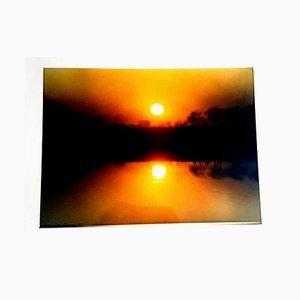
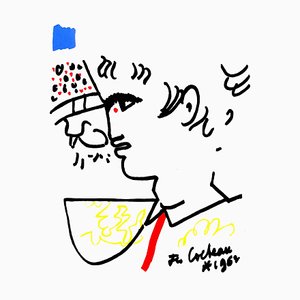
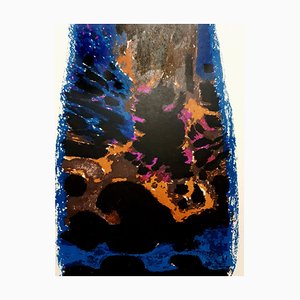
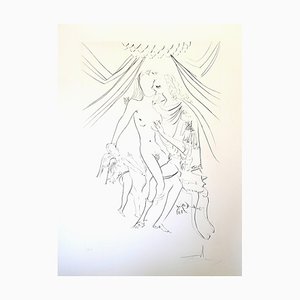
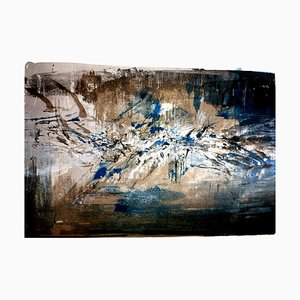
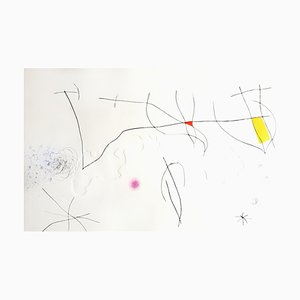
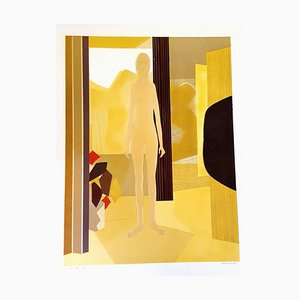
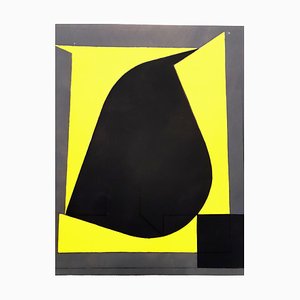
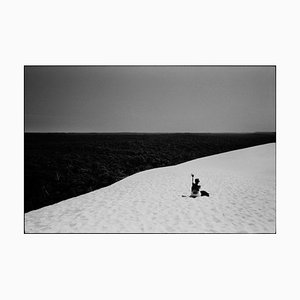
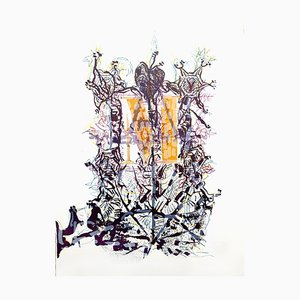
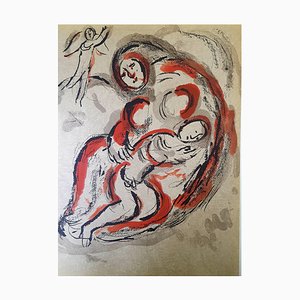
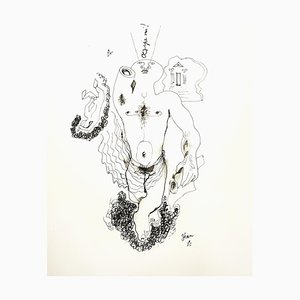
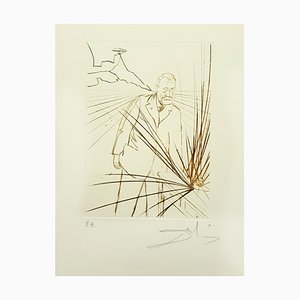
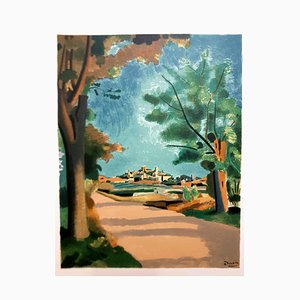
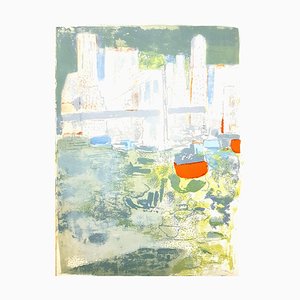
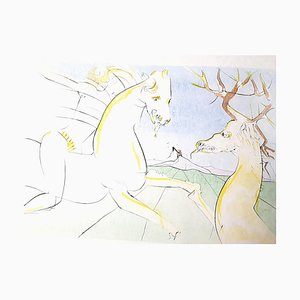
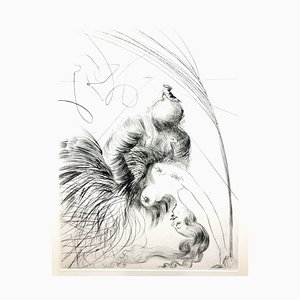
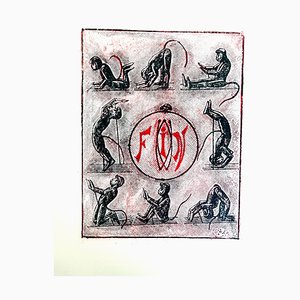

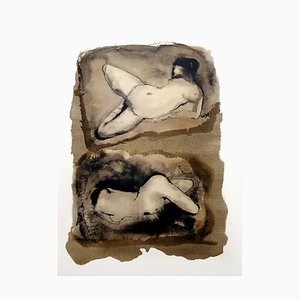
Contattaci
Fai un'offerta
Abbiamo notato che sei nuovo su Pamono!
Accetta i Termini e condizioni e l'Informativa sulla privacy
Contattaci
Fai un'offerta
Ci siamo quasi!
Per seguire la conversazione sulla piattaforma, si prega di completare la registrazione. Per procedere con la tua offerta sulla piattaforma, ti preghiamo di completare la registrazione.Successo
Grazie per la vostra richiesta, qualcuno del nostro team vi contatterà a breve.
Se sei un professionista del design, fai domanda qui per i vantaggi del Programma Commerciale di Pamono